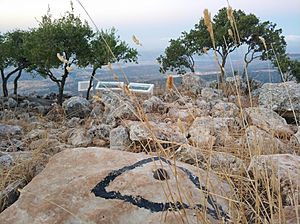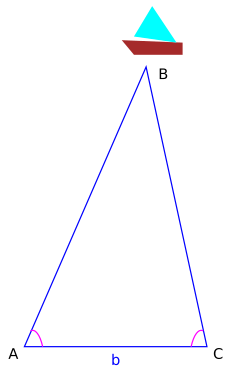Triangulation facts for kids
Triangulation is a clever way to find out where something is located. It uses triangles to figure out the exact spot of a point. You start from places you already know, and then you create triangles that reach the unknown point. This method is a big part of trigonometry and geometry, which are branches of mathematics dealing with shapes and measurements.
Contents
How is Triangulation Used?
Triangulation helps us measure things without having to go right up to them. It's used in many different fields, from mapping out land to helping robots see.
Triangulation in Surveying
In surveying, which is the science of mapping land, triangulation is super useful. Surveyors measure only the angles from known points. They don't need to measure the direct distance to the new point. This is different from "trilateration," where you measure distances. Sometimes, surveyors use both angles and distances; this is called "triangulateration."
Triangulation in Computers
Computers also use triangulation to "see" and understand the world. Systems like Computer stereo vision and 3D measuring tools use this idea. They figure out the size and shape of objects.
Imagine two "eyes" (sensors) looking at an object. One "eye" is usually a digital camera. The other can be another camera or a light projector. These two "eyes" and a point on the object form a triangle in space. The distance between the two "eyes" is the base of this triangle, and it must be known. By measuring the angles from the "eyes" to the object, the computer can calculate where the object is in 3D space.
The History of Triangulation

People have used triangles to estimate distances for a very long time. It's not a new idea!
Around 600 BC, a Greek thinker named Thales used similar triangles to guess the height of the pyramids in ancient Egypt. He measured the length of the pyramid's shadow and his own shadow at the same time. Then, he compared these lengths to his own height. This helped him figure out the pyramid's height. Thales also estimated how far ships were from a cliff by using similar methods.
The ancient Egyptians were also familiar with these ideas. A thousand years before Thales, an old document called the Rhind papyrus talked about "seqt" or "seked." This was a way to describe the slope of something, like the side of a pyramid. They used a special sighting rod, which the Greeks called a dioptra. This tool was an early version of the "alidade," which is still used today.
Later, a smart person named Hero of Alexandria (around 10–70 AD) wrote a detailed book called Dioptra. It showed many ways to find distances using this tool. This knowledge was lost in Europe for a while. But in 1615, Willebrord Snellius brought it back. He used these techniques to try and measure the size of the Earth.
In China, Pei Xiu (224–271) listed "measuring right angles and acute angles" as one of his six key rules for making accurate maps. This was important for correctly finding distances. Also, Liu Hui (around 263 AD) described how to measure distances to places that were hard to reach.
Today, triangulation is used for many things. It helps with surveying (mapping land), navigation (finding your way), and even in the military for aiming weapons.
See also
 In Spanish: Triangulación para niños
In Spanish: Triangulación para niños
- Direction finding
- GSM localization
- Multilateration, where a point is calculated using the time-difference-of-arrival between other known points
- Parallax
- Resection (orientation)
- Stereopsis
- Tessellation, covering a polygon with triangles
- Trig point
- Wireless triangulation



